MH370 search: 5 key questions into the missing Malaysian Airlines jet that still need answers
The interim report into the disappearance of MH370 may raise more questions than it answers

Your support helps us to tell the story
From reproductive rights to climate change to Big Tech, The Independent is on the ground when the story is developing. Whether it's investigating the financials of Elon Musk's pro-Trump PAC or producing our latest documentary, 'The A Word', which shines a light on the American women fighting for reproductive rights, we know how important it is to parse out the facts from the messaging.
At such a critical moment in US history, we need reporters on the ground. Your donation allows us to keep sending journalists to speak to both sides of the story.
The Independent is trusted by Americans across the entire political spectrum. And unlike many other quality news outlets, we choose not to lock Americans out of our reporting and analysis with paywalls. We believe quality journalism should be available to everyone, paid for by those who can afford it.
Your support makes all the difference.The interim report into the disappearance of MH370 is headed “Factual Information”. It contains an impressive level of detail, from the quantity of mangosteens in the hold (4.5 tons) to the financial affairs of the crew - with “no evidence of recent or imminent significant financial transactions carried out”. But it raises many more questions than it answers - starting with the most obvious.
Where is MH370?
Analysis of faint satellite “pings” has narrowed down the “priority search area” to an area of the Indian Ocean three times the size of Wales. The Australian-led search team has swept nearly half of the designated seabed without identifying anything that could be part of a debris field. From nearly six months of hunting with specialist vessels, all we know is where it (probably) isn’t.
Why has no debris ever been found?
The first physical evidence from plane crashes at sea normally takes the form of floating debris such as seat cushions and life jackets. That none has been found may be because the aircraft entered the water in a manner that kept the fuselage intact.
Who was at the controls?
If the plane is found, with the flight deck intact, we may find out.
What are we not being told?
Some personal information has been redacted in the report, but it appears that the detail is unimportant. More significant data may be held by foreign governments, in the shape of satellite reconnaisance data. But the military in the US, Russia and China may not wish the intensity of their surveillance to be known.
When will the search be abandoned?
The Australian government has talked of scaling the hunt back if nothing is found from the present phase. But the Malaysians and Chinese - whose citizens make up the majority of the lost souls - are determined for it to continue.
Join our commenting forum
Join thought-provoking conversations, follow other Independent readers and see their replies
0Comments